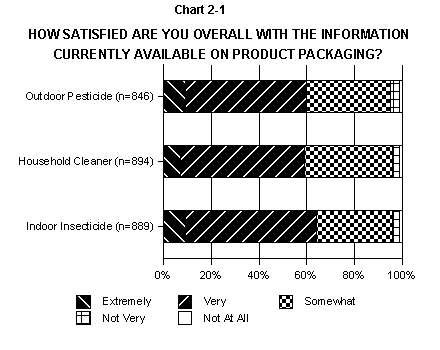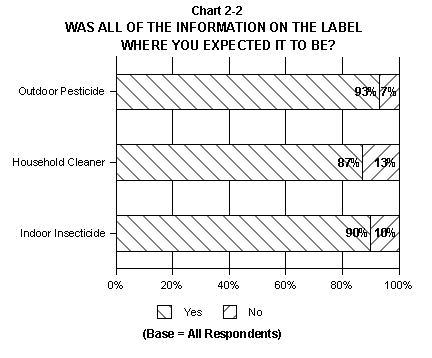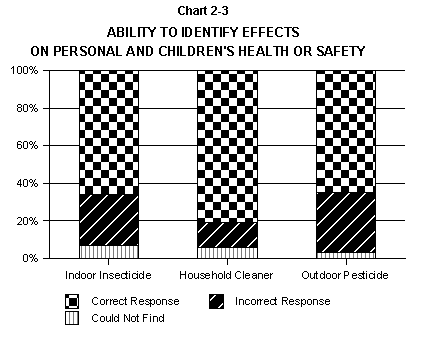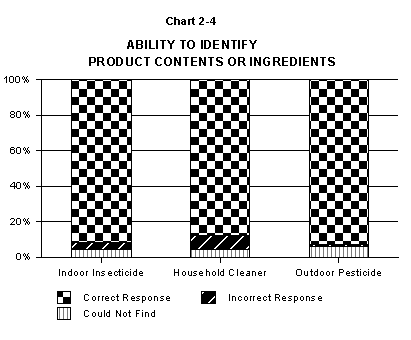|
The raw data tabulations were analyzed by the Research Core Group
for several reasons:
- to discover what overall findings, or observations, could
be made from the quantitative data about consumers' comprehension,
attitudes, behavior and satisfaction with labeling;
- to identify the implications, or connections, among the
various findings related to a learning objective or topic area;
and
- to evaluate labeling alternatives (for both registered and non-registered
products) in the outdoor pesticides, indoor insecticides, and
hard surface cleaner categories.
The Core Group hoped to be able to organize the findings in accordance
with the learning questions and the topic areas studied in the quantitative
research. Once in-depth analysis began, however, it became evident
that the data leading to the findings were not clear-cut, but in
fact overlapped with one or more of the learning objectives and
topic areas.
Wherever possible in this report, findings and implications have
been organized according to topic area. Data charts and tables follow
the findings that they support; most charts are presented in both
graphic and numerical formats. Implications of the findings are
provided following the findings from which these have been drawn.
Learning Objectives and Topic Areas
The quantitative survey was designed to address six learning objectives
identified by the CLI Partner and Task Force members at the beginning
of Phase II.
|
Quantitative Learning Objectives
Determine the current situation relative to consumers' satisfaction
with the format and content of existing labels;
Determine consumers' hierarchy of importance of basic label
information;
Determine where on the label consumers expect to find particular
information, such as First Aid and ingredients;
Determine consumers' current comprehension of label language;
Determine whether or not a preference exists for non-FIFRA
over FIFRA labels (for household cleaner category only); and
Determine consumers' reaction to standardized safe use,
environmental, health and safety information.
|
In addition to the learning objectives, the quantitative study
also focused on the following topic areas:
|
Specific Topic Areas Addressed by the Quantitative Research
Consumer Education -- What other sources of information,
besides the product label, do consumers turn to for information
about the product?
Product Ingredients -- Do consumers understand the
ingredient listing on products and know how to use this information?
Signal Words -- Do consumers understand the signal
word hierarchy for CAUTION, WARNING, and DANGER?
Storage and Disposal -- What are consumers' current
storage and disposal practices?
Precautionary Statements -- What are consumers' understanding
and use of precautionary statements?
|
Findings and Implications
Terminology
Findings are observations resulting directly from the quantitative
survey results and are supported by the data.
Implications show connections among the various findings
related to a topic or learning objective and are derived from consideration
of the quantitative findings.
Findings on Respondents' Satisfaction with Existing
Labels (Chart 2-1, Table 2-2)
In general, respondents expressed overall satisfaction with the
product labels in the three product categories. However, when presented
with specific alternate label formats or language preferences, they
indicated a desire for specific changes.

Table 2-2: How Satisfied Are You Overall With the Information Currently Available on Product Packaging? (%)
| |
Extremely |
Very |
Somewhat |
Not Very |
Not At All |
| Outdoor Pesticide |
9 |
51 |
35 |
4 |
1 |
| Household Cleaner |
7 |
52 |
37 |
3 |
1 |
| Indoor Insecticide |
9 |
55 |
32 |
3 |
1 |
(Base = All Respondents)
Findings on Respondents Comprehension of Existing Labels
(Tables 2-3, 2-4, 2-5)
1. Overall respondents' comprehension of the label sections was
high in all three product categories. A consistent exception to
this finding is that over half of the respondents found the words
in the ingredients section to be confusing.
2. The overwhelming majority of respondents for all three product
categories said there were no confusing words or phrases in any
of the various label sections. In the outdoor pesticides category,
however, over one third said there were confusing words or phrases
in the environmental hazards section.
3. In all three product categories, respondents preferred the alternative,
revised statements over the existing label language, with only a
few limited exceptions.
4. In each of the three product categories, comprehension of the
label language was high, with just a few exceptions. However, there
are noteworthy findings for Indoor insecticides and outdoor pesticide
categories:
- For indoor insecticides -- nearly one-half of the respondents
indicated that there was something confusing about the First Aid
section of the label. A large majority of these respondents had
difficulty with the phrase "gastric lavage is indicated if material
is taken internally."
- For outdoor pesticides -- one-third of the respondents
indicated confusion with the Environmental Hazards section. The
phrase "This product is toxic to aquatic invertebrates" was mentioned
most often as the source of this confusion.
5. Respondents were fairly definitive with regard to the preference
for various statements tested related to household cleaners. In
particular, each statement had two-thirds or more of the respondents
preferring one alternative or the other. Please refer to the following
table for a complete listing of statement preferences.
Table 2-3: Preference Statements for Household Cleaner Labels
| % Preferring |
Statement A |
Statement B |
% Preferring |
| 66.8 |
For safe and effective use, read the
label first |
Use safely. Read the label before
use |
33.2 |
| 66.8 |
For safe and effective use, read the
label first |
Use safely. Read the label before
use |
33.2 |
| 32.0 |
For safe and effective use, read the
label first |
Use only as directed on this label |
68.0 |
| 87.4 |
Hazards to humans and animals |
Effects on humans and animals |
12.6 |
| 78.4 |
Environmental hazards |
Effects on the environment |
21.6 |
| 73.1 |
Avoid contact with eyes |
Protect your eyes during application.
Wear safety glasses. |
26.9 |
6. While consumers exhibited strong preference for certain statements
on indoor insecticide labels such as "Can be absorbed through skin"
(97%) versus "Can be absorbed dermally" (3%), there was considerably
less agreement on statements such as "Do not re-enter for X hours
after application" (52%) versus "Allow X hours before re-entering
treated rooms" (48%). Please refer to the following table for a
complete listing of statement preferences.
Table 2-4: Preference Statements for Indoor Insecticide Labels
| % Preferring |
Statement
A |
Statement
B |
% Preferring |
|---|
| 33.8 |
Repeat
as needed |
Apply
no more than X treatments per week |
66.2 |
| 24.5 |
Do
not allow children or pet to contact treated areas |
Keep
children or pets out of treated areas for X minutes |
75.5 |
| 41.7 |
For
safe and effective use, read the label first |
Use
only as directed on this label |
58.3 |
| 91.0 |
Hazards
to humans and animals |
Human
and animal effects |
9.00 |
| 85.5 |
Environmental
hazards |
Environmental
effects |
14.5 |
| 56.8 |
Avoid
contact with eyes |
Protect
your eyes during application. Wear safety glasses. |
43.2 |
| 48.0 |
Allow
X hours before re-entering treated rooms |
Do
not re-enter for X hours after application |
52.0 |
| 57.1 |
Use
only in well-ventilated area |
Open
windows before use to provide free flow of air |
42.9 |
| 30.4 |
Do
not spray directly over food or utensils |
Do
not apply where spray may settle onto food or utensils |
69.6 |
| 3.0 |
Can
be absorbed dermally |
Can
be absorbed through skin |
97 |
7. Consumers exhibited strong preferences for certain statements
found on outdoor pesticide labels such as "Hazards to humans and
animals" (96%) versus "Human and animal effects" (4%). There was
considerably less agreement on statements such as "This pesticide
can kill wildlife" (56%) versus "This pesticide is toxic to wildlife"
(44%). Please refer to the following table for a complete listing
of statement preferences.
Table 2-5: Preference Statements for Outdoor Pesticide Labels
| %
Preferring |
Statement
A |
Statement
B |
%
Preferring |
| 35.0 |
Use
safely. Read the label before use |
Use
only as directed on this label |
65.0 |
| 96.3 |
Hazards
to humans and animals |
Human
and animal effects |
3.70 |
| 89.8 |
Environmental
hazards |
Environmental
effects |
10.2 |
| 6.10 |
Re-entry
not allowed until sprays are dry |
Do
not re-enter treated area until spray has dried |
93.9 |
| 27.9 |
Do
not apply directly to water |
Do
not apply directly to lakes, streams, rivers, or ponds |
72.1 |
| 14.5 |
Do
not contaminate water when disposing of equipment washwaters
or rinsate |
Do
not dump rinse water into sewers or other bodies of water |
85.5 |
| 10.8 |
Do
not contaminate water when disposing of equipment washwaters
or rinsate |
Do
not dump leftover pesticide or rinse water into drains or sewers |
89.2 |
| 3.90 |
Do
not use where soils are permeable |
Do
not use where product may seep into ground water |
96.1 |
| 11.7 |
Do
not use where soils are permeable |
Do
not apply to sandy soils |
88.3 |
| 44.2 |
This
pesticide is toxic to wildlife |
This
pesticide can kill wildlife |
55.8 |
| 41.0 |
This
pesticide is toxic to wildlife and domestic animals |
This
pesticide may harm pets and wildlife |
59.0 |
| 5.6 |
Do
not apply when weather conditions favor drift from treated areas |
Do
not apply in windy conditions. Pesticides may drift away from
application site |
94.4 |
| 3.5 |
Pre-harvest
Interval-allow X hours before picking or eating crops |
Do
not pick or eat garden crops for X hours after application |
96.5 |
| 33.7 |
Drift
or runoff may adversely affect fish and nontarget plants |
Drift
or runoff may unintentionally harm fish and plants |
66.3 |
| 2.60 |
Phytotoxic
to woody plants |
Application
may injure woody plants |
97.4 |
| 76.4 |
Wrap
in paper and dispose of in trash |
For
information on safe disposal of unused product, contact a household
hazardous waste program, or your local or state environmental
agency |
23.6 |
| 46.9 |
Do
not apply where runoff can occur |
Do
not use on sloped areas when heavy rain is expected |
53.1 |
| 22.3 |
Repeated
contact may cause skin sensitization reactions in come individuals.
Avoid contact with skin. |
May
cause skin allergies to develop. Avoid contact with skin |
77.7 |
8. There were demographic differences in respondents' comprehension
of the labels:
- Respondents in higher income categories understood labels better.
- Respondents at higher education levels understood labels better.
- Respondents in the younger age categories understood labels
better.
9. Ability to locate information on the label and comprehension
of that information correlate positively with income and education
and correlate inversely with age. This is true despite higher reported
interest in label information among the elderly, less educated,
and lower income participants in the survey.
10. Interest in specific information on labels (e.g., looking for
information on harmful effects) correlates positively with understanding
labels.
Findings on Respondents' Ease of Locating Information
on Labels (Chart 2-2, Table 2-6, Table 2-7)
11. In all three product categories, an overwhelming majority of
respondents indicated that the information on the label was where
they expected it to be. Of those who did not find the information
where they expected, the most popular suggestion was to put the
ingredients on the back label. (For specific product information,
see Charts 2-3 and 2-4 and Table 2-7.)
12. The information respondents found most difficult to locate
on product labels were:
- For all three product categories -- where the product
should not be used.
- For outdoor pesticides -- First Aid information and precautions
to pets and the environmental effects for wildlife.
- For indoor insecticides -- precautions to personal health.

Table 2-6: Was All of the Information on the Label Where You Expected It To Be? (%)
| |
Yes |
No |
| Outdoor Pesticide |
93 |
7 |
| Household Cleaner |
87 |
13 |
| Indoor Insecticide |
90 |
10 |
(Base = All Respondents)

Table 2-7: Ability to Identify Effects on Personal and Children's Health or Safety (%)
| |
Could Not Find |
Incorrect Response |
Correct Response |
| Outdoor Pesticide |
3 |
32 |
65 |
| Household Cleaner |
6 |
13 |
81 |
| Indoor Insecticide |
7 |
27 |
66 |
(Base = All Respondents)

Table 2-8: Ability to Identify Product Contents or Ingredients (%)
| |
Could Not Find |
Incorrect Response |
Correct Response |
| Outdoor Pesticide |
6 |
1 |
93 |
| Household Cleaner |
4 |
8 |
88 |
| Indoor Insecticide |
4 |
4 |
92 |
(Base = All Respondents)
Implications Regarding Respondents' Comprehension
of and Ease of Locating Information on Product Labels
A. There is a need to make certain label sections easier
to find quickly.
B. There are ways in which label sections can be made easier
to find quickly, read and comprehend.
C. Most of the word and phrase revisions were preferred and
would increase comprehension of the label.
|
Findings on Respondents' Hierarchy of Importance of
Information on Product Labels (Chart 2-5, Chart 2-6, Table 2-9,
Table 2-10, Table 2-11, Table 2-12, Table 2-13)
13. For all three product categories, the label information that
respondents read in the store and before use included: brand name,
directions for use, a description of what the product does, a description
of where not to use the product, and precautions for the effects
on personal and children's health.
14. The frequencies of reading labels were significantly higher
among outdoor pesticides users followed by indoor insecticides users
followed by household cleaners users. This is true for nearly all
sections of the label.
![Chart 2-5: Frequency of Reading [certain parts of the label] in the store. (please find the results in the table.)](../gif/chap2s5.gif)
Table 2-9: Frequency of Reading in Store (%)
| |
Brand Name |
Directions |
Description/
What It Does |
Where Not To
Use |
Health Effects |
Manufacturer |
| Outdoor Pesticide |
88 |
83 |
82 |
79 |
73 |
65 |
| Household Cleaner |
87 |
64 |
63 |
59 |
53 |
56 |
| Indoor Insecticide |
87 |
78 |
77 |
71 |
68 |
57 |
Base = All Respondents
[Go to next section]
|
![[logo] US EPA](../gif/logo_epaseal.gif)




![Chart 2-5: Frequency of Reading [certain parts of the label] in the store. (please find the results in the table.)](../gif/chap2s5.gif)